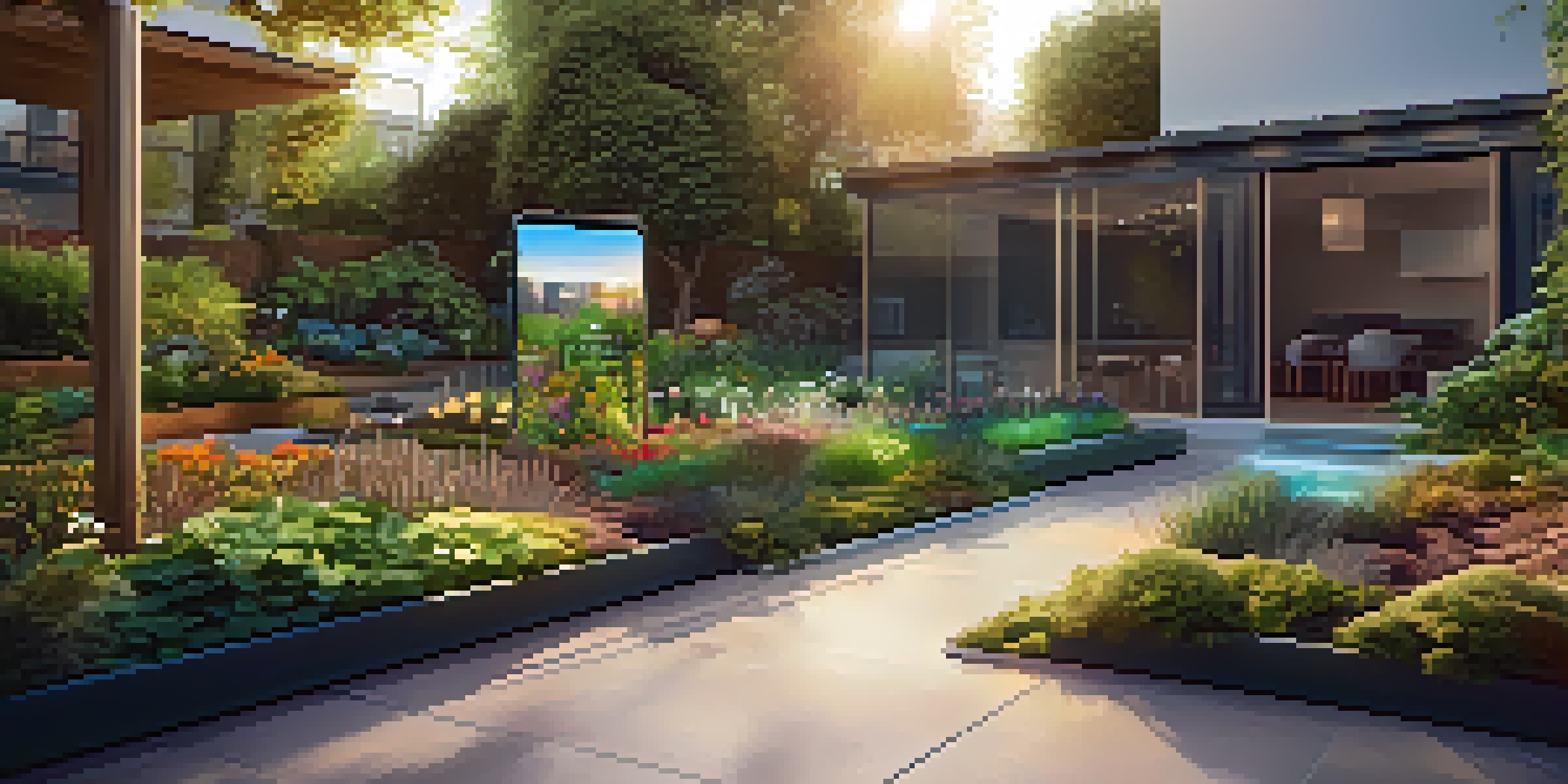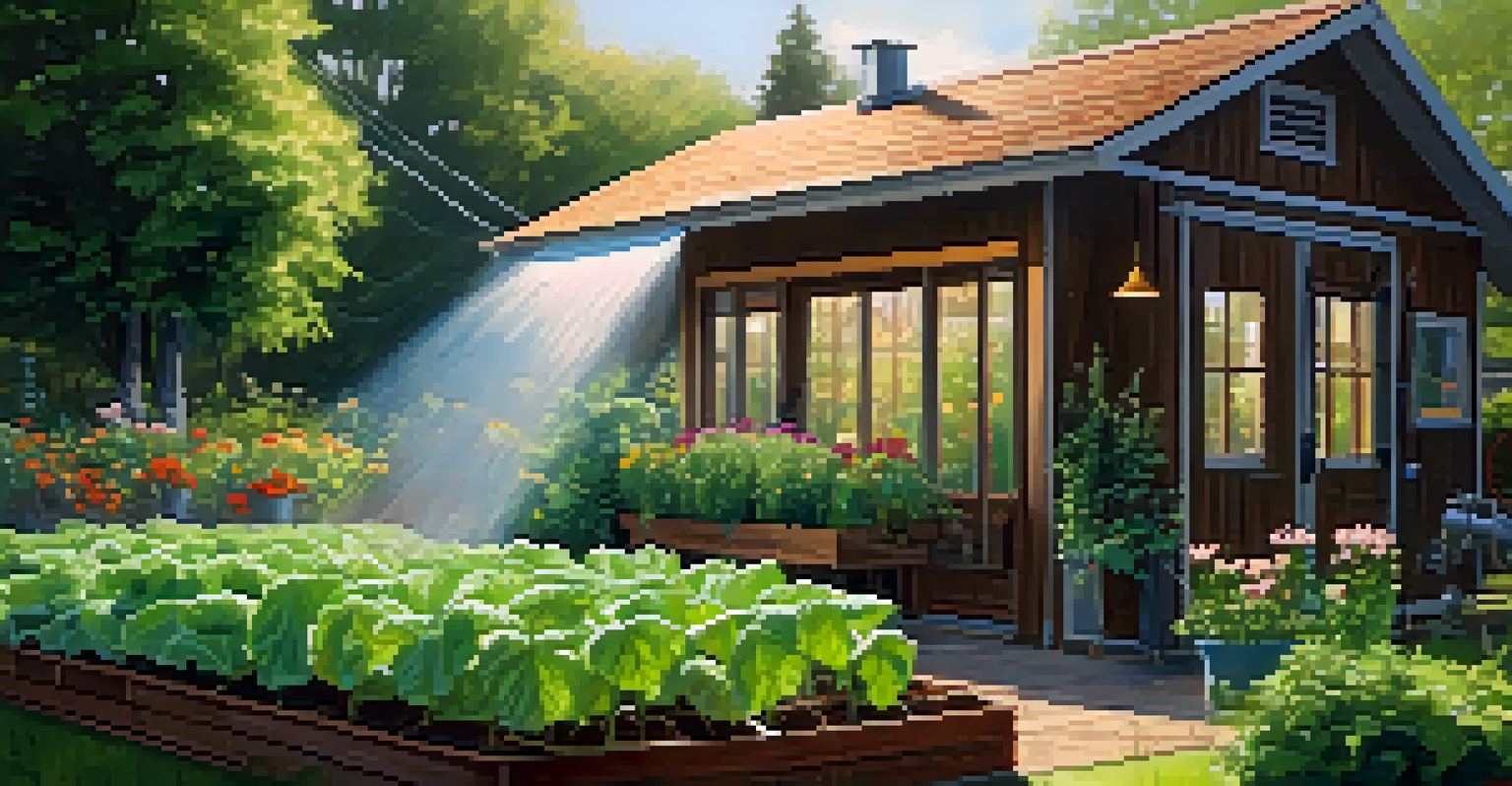Smart Gardening: Using Technology to Optimize Urban Gardens

Understanding Smart Gardening and Its Benefits
Smart gardening combines traditional gardening methods with modern technology, creating a system that can optimize growth and efficiency. Imagine being able to monitor your plants' needs from your smartphone, ensuring they receive just the right amount of water and nutrients. This approach not only saves time but also promotes sustainability in urban environments, making it an attractive option for busy city dwellers.
Gardening is a way of showing that you believe in tomorrow.
By integrating technology, gardeners can achieve better yields and healthier plants, while reducing waste. For instance, automated irrigation systems adjust water levels based on real-time weather data, preventing overwatering and conserving resources. In a world where urban spaces are becoming increasingly limited, smart gardening provides a viable solution to grow food in smaller areas without sacrificing quality.
Furthermore, smart gardening encourages a more connected community. With shared platforms and apps, urban gardeners can exchange tips, harvests, and even collaborate on community gardens. This social aspect not only fosters relationships but also enhances the overall gardening experience, making it more enjoyable and rewarding.
Essential Technologies for Urban Gardens
There are several technologies that can significantly enhance urban gardening. For example, smart sensors measure soil moisture, temperature, and light levels, sending data directly to your device. This allows you to assess the health of your plants without having to guess, making gardening more scientific and less trial-and-error.

Another popular technology is automated irrigation systems. These systems can be programmed to water your plants at specific intervals or adjust watering based on weather conditions, ensuring that your plants never suffer from drought or overwatering. Picture coming home from a long day to a flourishing garden that’s been perfectly watered while you were away.
Smart Gardening Enhances Efficiency
Integrating technology in gardening optimizes growth and resource use, making it easier for urban dwellers to maintain healthy plants.
Additionally, smart gardening apps provide a wealth of information, from plant care tips to pest management. These apps often feature community forums where gardeners can share experiences and solutions, making it easier to troubleshoot any challenges. Embracing these technologies not only boosts your gardening success but also makes it a more enjoyable hobby.
The Role of Smart Irrigation Systems
Smart irrigation systems are game-changers for urban gardens. By utilizing weather forecasts and soil moisture data, these systems can optimize watering schedules, ensuring that plants receive the right amount of water at the right time. This not only keeps your garden healthy but also conserves precious water resources, which is crucial in urban settings.
The best time to plant a tree was twenty years ago. The second best time is now.
For instance, imagine a drip irrigation system equipped with sensors that detect moisture levels in the soil. When the soil is sufficiently moist, the system automatically pauses watering, preventing waste. This technology not only promotes plant health but also lowers your water bill, making it a win-win for both your garden and your wallet.
Moreover, smart irrigation can be controlled remotely, allowing you to manage your garden from anywhere. Whether you’re at work or on vacation, you can ensure your plants are thriving with just a few taps on your smartphone. This level of control adds convenience and peace of mind, making gardening accessible for even the busiest urbanite.
Using Sensors for Optimal Plant Health
Sensors are an invaluable tool in smart gardening, providing real-time data to help you understand your plants’ needs. These devices can monitor various factors such as soil moisture, pH levels, and ambient temperature, giving you a comprehensive view of your garden’s health. Think of them as a personal health monitor for your plants, alerting you to any changes that need attention.
For example, if a sensor detects that the soil pH is too high for your tomatoes, you can take immediate action to correct it, ensuring optimal growth. This proactive approach can prevent potential issues before they escalate, leading to healthier plants and better yields. It's all about harnessing technology to make informed decisions.
Tech Solutions for Urban Gardens
Tools like smart sensors and automated irrigation systems help monitor plant health and manage watering efficiently.
Additionally, many sensors come with accompanying apps that allow you to track changes over time. This data can help you identify trends and patterns in your gardening, such as which plants thrive in specific conditions. By becoming more attuned to your garden's needs, you can cultivate a thriving urban oasis.
The Value of Gardening Apps
Gardening apps are essential companions for urban gardeners, offering a treasure trove of information at your fingertips. From plant identification to care reminders, these apps make gardening accessible for everyone, regardless of experience level. Imagine being able to snap a photo of a plant and instantly receive care instructions – how convenient is that?
Some apps even feature augmented reality, allowing you to visualize how different plants will look in your space before you commit. This can be especially helpful in urban settings, where space is limited, and every plant choice counts. With just a few taps, you can design a garden that not only looks good but also thrives in your specific environment.
Moreover, many gardening apps foster a sense of community. Users can share their successes, challenges, and tips, creating a supportive network of urban gardeners. This shared knowledge is invaluable, as it helps you learn from others' experiences and encourages a collaborative approach to gardening.
Sustainable Practices in Smart Gardening
Sustainability is at the heart of smart gardening, as technology helps minimize waste and maximize efficiency. For example, composting systems can be connected to your garden’s needs, recycling kitchen scraps into nutrient-rich soil. This not only reduces landfill waste but also enriches your garden, creating a closed-loop system that benefits both you and the environment.
Additionally, smart gardening encourages the use of native plants, which are better adapted to local conditions and require less water and care. By utilizing technology to identify the best plants for your space, you can create a lush garden that thrives with minimal input. This approach highlights the harmony between nature and technology, showing that they can coexist beautifully.
Sustainability Through Smart Practices
Smart gardening practices promote sustainability by minimizing waste, encouraging native plants, and enhancing biodiversity.
Furthermore, many smart gardening solutions promote biodiversity, which is essential for a healthy ecosystem. By attracting pollinators and beneficial insects, you can create a vibrant garden that supports local wildlife. This not only enhances your gardening experience but also contributes to the overall health of your urban environment.
Creating a Smart Garden: Getting Started
Getting started with smart gardening doesn’t have to be overwhelming. Begin by assessing your space and determining what technologies will best suit your needs. Whether you choose to install sensors, smart irrigation systems, or download gardening apps, starting small can help you gradually integrate technology into your gardening routine.
Next, consider your plant choices. Opt for varieties that thrive in your local climate and are well-suited for urban gardening. This will make it easier to manage your garden while maximizing your success. Remember, the goal is to create a thriving ecosystem that works in harmony with the technology you implement.

Finally, embrace the learning curve. Smart gardening is an evolving field, and there’s always something new to discover. As you experiment with different technologies and practices, you’ll find what works best for your unique situation. This journey not only enhances your gardening skills but also deepens your connection to nature and your community.